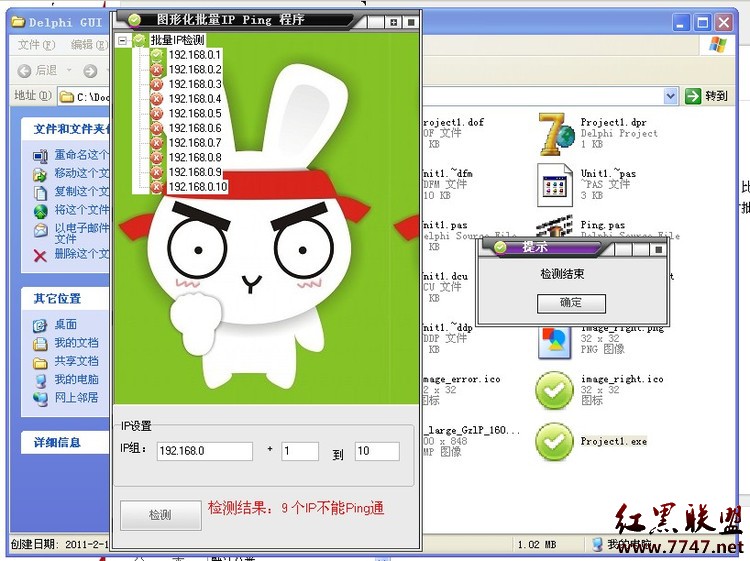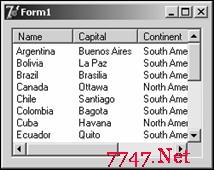VCL中消息处理初探
TObject是基类,所以我们先看一下TObject的DISPATCH方法。Dispatch根据传入的message来寻找相应的消息处理方法,如果找不到的话,就继续向上到父类的消息处理方法表中寻找响应的处理方法,一直到找到为止,如果找到顶还没有,则调用DefaultHandle来处理该消息。message可以是任何的类型,Dispatch假设message的头两位是消息的ID,它就是根据ID来寻找消息处理方法的。虽然任何类型的message都可以被接受,但是TObject的子类还是希望传入的message参数是TMessage的记录类型或其他证明的记录类型。
以下声明和注释摘自与system.pas:
{ TObject.Dispatch accepts any data type as its Message parameter. The
first 2 bytes of the data are taken as the message id to search for
in the objects message methods. TDispatchMessage is an example of
such a structure with a word field for the message id.
}
TDispatchMessage = record
MsgID: Word;
end;
类的继承关系如下:
TObject->TPersistent->TComponent->TControl
TControl是所以可视化组件的父类,TControl提供了一个新的方法,WndProc:
procedure TControl.WndProc(var Message: TMessage);
var
Form: TCustomForm;
KeyState: TKeyboardState;
WheelMsg: TCMMouseWheel;
begin
//如果处在设计期
if (csDesigning in ComponentState) then
begin
Form := GetParentForm(Self);//得到拥有该组件的窗体
if (Form <> nil) and (Form.Designer <> nil) and
Form.Designer.IsDesignMsg(Self, Message) then Exit //消息由窗体来处理
end;//窗体可以为其拥有的组件来处理键盘消息。
if (Message.Msg >= WM_KEYFIRST) and (Message.Msg <= WM_KEYLAST) then
begin
Form := GetParentForm(Self);
if (Form <> nil) and Form.WantChildKey(Self, Message) then Exit;
end//关于鼠标的消息
else if (Message.Msg >= WM_MOUSEFIRST) and (Message.Msg <= WM_MOUSELAST) then
begin
//如果组件不可以接受和处理双击消息,就将双击消息映射为单击消息。
if not (csDoubleClicks in ControlStyle) then
case Message.Msg of
WM_LBUTTONDBLCLK, WM_RBUTTONDBLCLK, WM_MBUTTONDBLCLK:
Dec(Message.Msg, WM_LBUTTONDBLCLK - WM_LBUTTONDOWN);
end;
case Message.Msg of
WM_MOUSEMOVE: Application.HintMouseMessage(Self, Message);//如果是鼠标移动的消息,则出现hint窗口
WM_LBUTTONDOWN, WM_LBUTTONDBLCLK://如果是左键被按下,或者双击,如果是自动拖动模式,则开始拖动,并将左键按下的状态加入组件的状态。
begin
if FDragMode = dmAutomatic then
begin
BeginAutoDrag;
Exit;
end;
Include(FControlState, csLButtonDown);
end;
WM_LBUTTONUP:
Exclude(FControlState, csLButtonDown); //如果是左键放开,则将左键按下的状态剔除。
else
with Mouse do
if WheelPresent and (RegWheelMessage <> 0) and //如果鼠标有滚轮,并且滚轮滑动时发出了消息
(Message.Msg = RegWheelMessage) then
begin
GetKeyboardState(KeyState); //将256虚拟键的状态拷贝到缓存中去
with WheelMsg do //填充记录
begin
Msg := Message.Msg;
ShiftState := KeyboardStateToShiftState(KeyState);
WheelDelta := Message.WParam;
Pos := TSmallPoint(Message.LParam);
end;
MouseWheelHandler(TMessage(WheelMsg)); //派发鼠标滚轮的消息
Exit;
end;
end;
end
else if Message.Msg = CM_VISIBLECHANGED then
with Message do
SendDockNotification(Msg, WParam, LParam); //处理自定义消息
Dispatch(Message); //派发未处理的消息
end;
但是只有TWinControl可以获得焦点:
procedure TWinControl.WndProc(var Message: TMessage);
var
Form: TCustomForm;
begin
case Message.Msg of
WM_SETFOCUS: //设置控件的焦点
begin
Form := GetParentForm(Self);
if (Form <> nil) and not Form.SetFocusedControl(Self) then Exit;
end;
WM_KILLFOCUS:
if csFocusing in ControlState then Exit;
//当鼠标有活动的时候发出该消息,如果鼠标没有被捕捉到,则消息发往鼠标下面的那个窗口,否则消息将发往捕捉到鼠标的那个窗口。
WM_NCHITTEST:
begin
inherited WndProc(Message); //调用父类的处理方法
//如果窗体被挡住并且在指定的点没有控件,则返回结果为在client区。
if (Message.Result = HTTRANSPARENT) and (ControlAtPos(ScreenToClient(
SmallPointToPoint(TWMNCHitTest(Message).Pos)), False) <> nil) then
Message.Result := HTCLIENT;
Exit;
end;
WM_MOUSEFIRST..WM_MOUSELAST:
if IsControlMouseMsg(TWMMouse(Message)) then //鼠标消息是否直接发往组件的窗体子组件
begin
{ Check HandleAllocated because IsControlMouseMsg might have freed the
window if user code executed something like Parent := nil. }
if (Message.Result = 0) and HandleAllocated then
DefWindowProc(Handle, Message.Msg, Message.wParam, Message.lParam);//调用默认的的消息处理方法对该消息进行默认处理。
Exit;
end;
WM_KEYFIRST..WM_KEYLAST:
if Dragging then Exit;
WM_CANCELMODE:
if (GetCapture = Handle) and (CaptureControl <> nil) and
(CaptureControl.Parent = Self) then
CaptureControl.Perform(WM_CANCELMODE, 0, 0);
end;
inherited WndProc(Message);
end;
补充:软件开发 , Delphi ,




